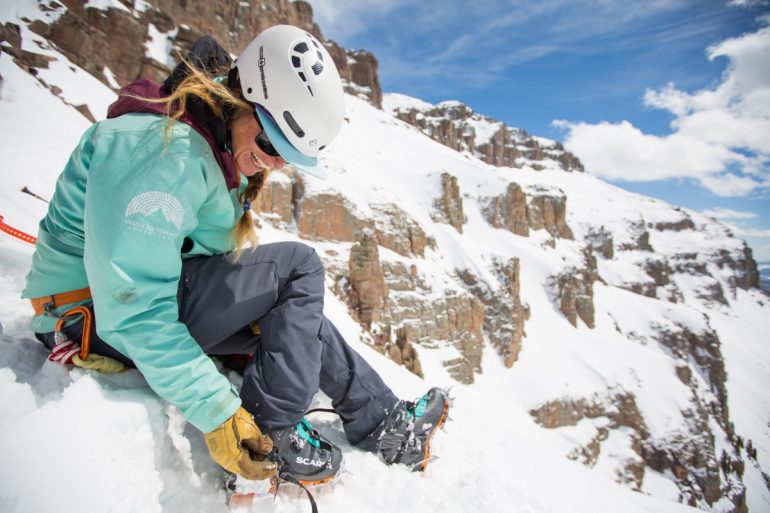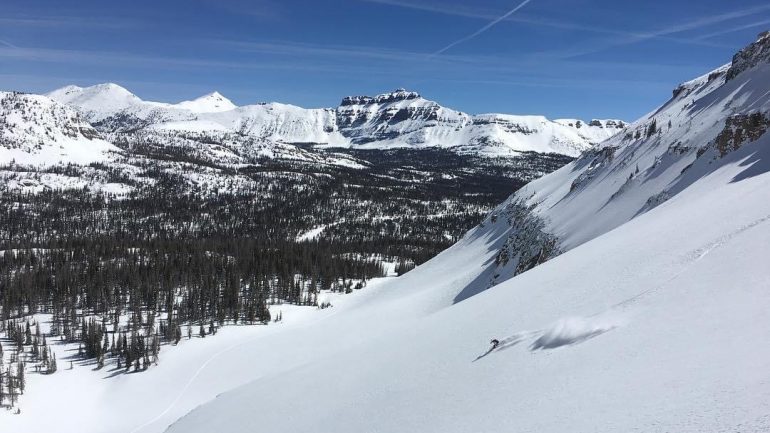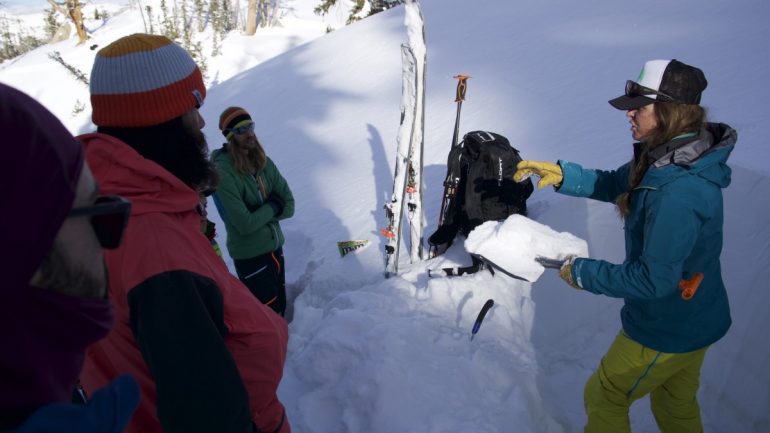Shaun Deutschlander has witnessed ski touring’s popularity boom first hand. She is the founder and lead guide at Inspired Summit Adventures, a year round guide service that offers custom backcountry ski trips, mentorship and avalanche classes. The company is based in Park City, Utah and operates right in the heart of “Wasangeles”, one of the most accessible and fastest growing backcountry zones in the country.
As the editor of this site, I spend a lot of time following ski touring news and articles. A common theme I’ve noticed this season is the foreboding attitude that pervades conversations about the backcountry getting busier. Of course, it makes sense — many of us head off piste to get away from people and ski untracked snow. A busier backcountry puts both of those experiences (among others) in question.
A few weeks back, I stumbled on an a short interview Shaun gave about the positive potential of a busier backcountry. And so, I decided to call her up to hear more about what that could look like.
WS: How’s the winter been so far? What trips and courses have been the most popular?
SD: We, like much of the backcountry industry, have exploded with bookings. We were on a really strong growth projection over the last seven years but then Covid multiplied everything for us by 500 percent.
The most popular trip has definitely been our mentorship program. It’s a three-day totally custom itinerary that focuses on everything from avalanche education to technical skills. In the spring we might have someone coming out looking to get more into ski mountaineering so we’ll work on uphill travel, rope work and stuff like that. We do movement skills, too, someone wants to be a better powder skier or wants to learn what backcountry skiing is all about.
WS: Are you seeing a different kind of clientele?
SD: It’s an unprecedented number of people just getting into it. ‘Hey I got all the gear for Christmas, I want to try it.’ Or, ‘hey I’m going to rent the stuff to see if I like this.’ Or, ‘I’ve never done it but am an advanced skier at the resort.’ Definitely way more never-evers.
WS: I haven’t skied much in Utah and the Wasatch area, but I hear it’s pretty popular for ski touring. What’s the vibe this winter? Is it noticeably busier like everyone is expecting it would be?
SD: I’d say it’s 100% busier. Every trailhead is full, which was a hurdle before Covid. You have to think ahead and have a couple trailheads in mind before going out so you have options A, B and C.
At the trailheads, there’s kind of a tailgaiting vibe (laughs) it’s not all bad. I look around and see new users trying to learn these skills and that makes me happy. There’s a part of me that’s like, well look at this. People aren’t defeated, people aren’t deflated because there’s a pandemic. People are choosing to be motivated in the face of something that could really deflate a human, and they’re choosing to seek nature for expression, for freedom, for fun. And that to me is why I started doing what I do personally.
I teach avalanche courses and I always say after every course, let’s be encouraging members of the backcountry. At the end of the day that’s who we are, and who is out there with us are all these people we see at the trailhead.
And so what if somebody chooses to have music on a backpack playing while in the backcountry? Let’s not discount this person as not being a worthy human being because they choose that stylistic approach to the mountains. I think there’s a balance between passing judgement and walking around with some sort of ‘we’re all holier than thou because we’ve been out here for longer’. The more we can be open and inviting and listen to why somebody wants to have music playing in their backpack and then say, look, there’s a reason we don’t. It’s because we need to be in tune with the mountains. If your music is blaring, you’re not going to hear a booming collapse, you’re not going to hear the mountains talking to you. You might not pick up on the changes of wind direction, which all leads to your safety but our safety as a collective community out there.
WS: So, we can all work on trying to cultivate a culture of more openness and acceptance.
SD: Yeah. And I think Covid has fast-tracked so many trends that were already in place. We were already seeing this new user come in and this explosion in backcountry. My hope is that, when things are slow growth we can kind of hide a lot of bad behaviors and the repetitious sneaky slow evolution of things, but maybe with this all being in our face more, we have immediacy and so we can choose to respond and tweak our own reactions and interactions in a more profound and meaningful way than trying to whisper and deny, like ‘this isn’t really happening, it’s cool, we’re just going to keep back talking these new users,’ etc.
WS: What is your vision of what a friendly busier backcountry looks and feels like?
SD: There are certain circles in the Wasatch central core who are hoping to collaborate more and to have more of an inclusive community. One of the thoughts that was communicated during this year’s snow and avalanche workshop is how two way radios have become really popular and they’re an amazing tool. And they’re on open bandwidth, so anyone can jump on. So the thought was: why don’t we designate public channels for each drainage? That way if no one can see a group skinning up the line you’re about to drop you can communicate to them like ‘hey so you guys know we’re waiting up here. We’re not going to drop on top of you but so you know we’re here waiting to please don’t hang out and eat your lunch in the middle of our ski run.’
But like all new ideas, some people in the community were like, ‘Radios? I’m not out there to communicate, I’m not out there to make people feel better and make them feel more included in this experience. This was always about me, and this is where I always escape for me’. And they’re two very valid approaches.
My ultimate vision of a busier backcountry isn’t very idealistic, it’s just respect. Maybe I’m somebody who is more ‘I’m an individual, I’m not out there to be communicating with anyone’, but I do know that in the back of my head if I did need to communicate with somebody I’m going to carry a radio. That way I can be part of it when I need to and know that it’s a tool people are using. But I’m not going to have my radio on and I don’t care what everybody in Little Cottonwood Canyon is talking about.
And then other folks are like, this is cool. Communication is helpful. It’s helping the next generation lean on each other, build consensus, and learn from one another.
My thought is: The backcountry is going to get more busy. It is what it is. We can choose to be begrudging about it and create a very exclusive, unsafe environment, or we can choose to be inclusive and choose to communicate when needed and communicate with kindness and a vocabulary of inclusivity versus judgement and exclusivity.
That’s more a philosophical note of what I hope the backcountry becomes. I do hope I see and hear less radio backpacks (laughs) but again, I’m happy to talk to somebody and understand.
But also, my hope for my own personal self and for our community at large is to be honest with our own bias. We all have them. And understanding that we only know what we know. If we can remember that and hold on to that — like this whole new generation, they only know what they know. They know front side activities. They know how they’ve approached mountains as it pertains to being at a ski resort. So it’s not that they’re idiots or that they’re disrespectful, it’s that you really don’t know what you don’t know.
WS: Are any particularly bad or damaging faux pas that people are doing in the backcountry that maybe there should be more public service announcements about? For instance, we’ve gotten a lot of comments on the site about being aware of who’s below you and making sure you aren’t skiing on top of other people.
SD: That’s the number one, and the biggest message we’re trying to get across as professionals as avalanche educators, as avalanche forecasters communicating to the public: Be mindful of people below you. That’s not even that new to Covid, right because the Wasatch is such a consolidated range, we don’t have the boundary of physical fitness that some other places have.
Something else we’ve been talking about a lot is forecasters showing and using test slopes, really being aware that if you’re marching around remotely triggering avalanches that you know for certain that nobody is below you. Then there’s general etiquette too — don’t pee on the skintrack — and that sort of lightness.
We are such a ‘monkey see, monkey do’ species and culture. My whole goal, whether through Inspired Summit or AIARE avalanche education is really making sure that this new wave of backcountry users understands that their decision making matters. Those of us who’ve made a career of this, whether it’s a professional career or lifelong passion career, we ought to always know why we’re doing things and why we’re not doing things. How we’re approaching things and how we’re not approaching other things. Cultivating a culture of mindfulness in this new wave is something that I’m trying to do. I don’t know if it’s a bigger movement, but I’m doing it.
Manasseh Franklin is a writer, editor and big fan of walking uphill. She has an MFA in creative nonfiction and environment and natural resources from the University of Wyoming and especially enjoys writing about glaciers. Find her other work in Alpinist, Adventure Journal, Rock and Ice, Aspen Sojourner, AFAR, Trail Runner and Western Confluence.



